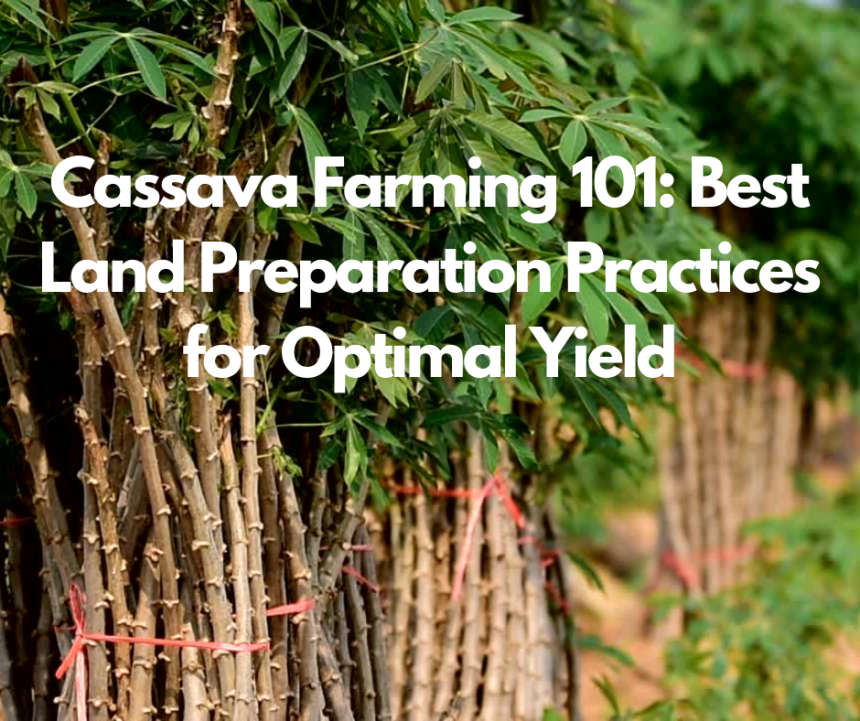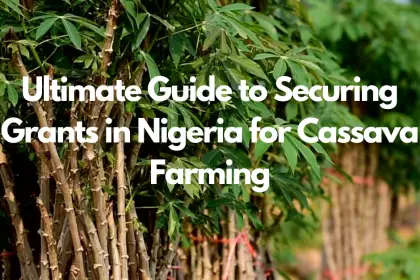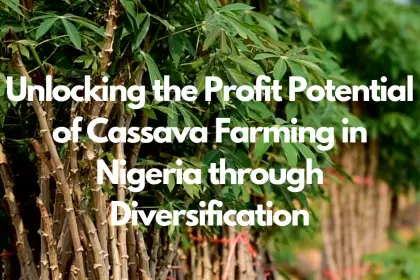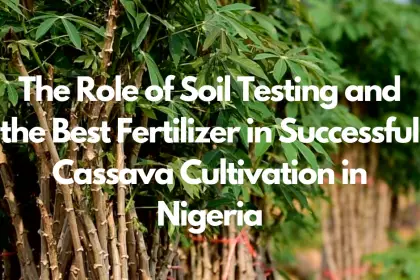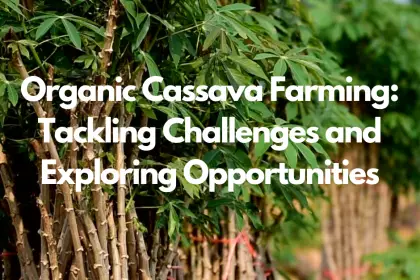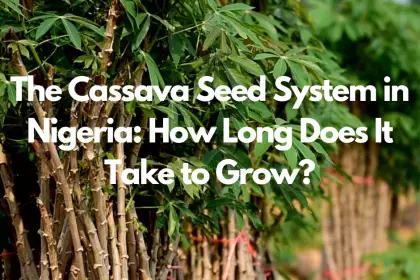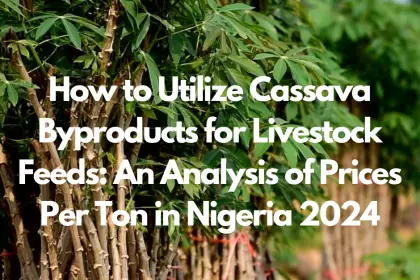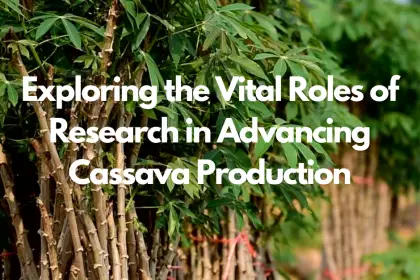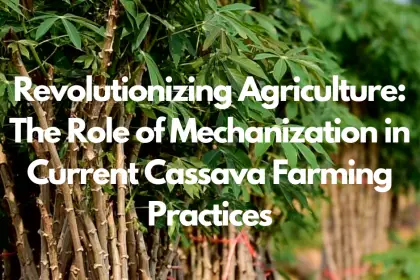Cassava farming plays a pivotal role in achieving food security, especially in tropical regions where it serves as a staple food for around 800 million people worldwide. With its origin tracing back to the southern edge of the Brazilian Amazon nearly 9,000 years ago, cassava has become integral to the diets and economies of over 100 countries, including Nigeria, the world’s largest producer. However, without sustainable practices, cassava farming can lead to significant environmental impacts such as habitat destruction and soil degradation.
Effective land preparation is crucial for optimizing cassava yield, a principle that holds paramount importance particularly in regions like Nigeria, where cassava production is a major agricultural activity. This article explores best practices for land preparation, from selecting the ideal site to choosing the right cassava variety and effective weed management. With a focus on enhancing productivity and sustainability, these guidelines aim to support small-scale farmers in improving both yield and environmental outcomes.
Understanding the Importance of Site Selection in Cassava Farming
Understanding the importance of site selection in cassava farming cannot be overstated, as it directly influences yield and the overall success of the crop. Key factors to consider include:
- Soil Quality and Topography:
-
- Opt for well-drained, fertile soil rich in nutrients to prevent waterlogging and root rot.
- Flat or gently sloping land is preferred over steep slopes to minimize erosion and nutrient leaching.
- Avoid flood-prone, swampy, stony, rocky, shaded areas, and newly cleared forest land.
- Climate Conditions:
-
- Cassava thrives in regions with evenly distributed rainfall and an ambient temperature between 25-30 degrees Celsius.
- An ideal site receives an annual rainfall of 1000 mm or more, with at least 6 months of rain and at least 50 mm rainfall per month.
- Avoid areas where drought stress or waterlogging could occur, as these conditions severely impact cassava growth.
- Biophysical and Socio-economic Requirements:
-
- Ensure the soil is not extremely stony or shallow (minimum depth of 30 cm) and is free from spear grass infestation.
- Check for the presence of earthworms and other signs of biological activity in the soil.
- Consider the field’s history, including previous crops, pests, diseases, and weeds, to anticipate potential challenges.By meticulously selecting the site for cassava farming, farmers in Nigeria and beyond can significantly enhance their crop’s yield and quality, contributing to food security and economic stability.
Best Practices for Land Preparation
To ensure cassava farming in Nigeria achieves optimal yield, land preparation practices must be strategic and sustainable. The following guidelines outline best practices tailored to various land conditions and emphasize sustainable intensification:
- Land Condition and Preparation Approach:
-
- Previously Cultivated or Short Fallow Land: Begin with slashing any present vegetation and apply glyphosate for effective weed control. Plough the soil to a depth of 15-30 cm, ensuring nutrient-rich topsoil remains accessible for the cassava roots.
- Older Fallow or Forest Growth: For lands with dense vegetation, slash the area to clear trees, shrubs, and broadleaves. If vegetation is too tall, consider ploughing as an alternative to manage the growth.
- Preparation Timing: Prepare the land at the end of the dry season, making it ready for planting with the onset of the rainy season, which is crucial for cassava growth.
- Soil Fertility and Erosion Control:
-
- Soil Fertility: Enhance soil nutrients and structure by applying manure, compost, and well-balanced mineral fertilizers. Intercropping and crop rotation can also contribute to soil health.
- Erosion Control: Use mulch to improve water retention, increase soil fertility, and reduce erosion. Preparing suitable seedbeds further aids in soil property improvement and erosion reduction.
- Sustainable Intensification Practices:
-
- Minimize Tillage: While cassava farming requires some level of soil disturbance, aim to minimize tillage where possible to preserve soil structure.
- Biological Control Agents: Implement the use of biological control agents to manage pests and diseases, reducing the reliance on chemical pesticides.
- Optimize Planting: Select the right cassava variety and optimize planting timing and methods to ensure the best possible yield.By following these land preparation practices, farmers can create a more productive, profitable, and sustainable cassava farming system in Nigeria.
Choosing the Right Cassava Variety
Choosing the right cassava variety is pivotal for achieving optimal yield and meeting market demands. Here’s a breakdown of considerations and popular varieties across Nigeria:
Considerations for Selecting Cassava Varieties:
- Early Maturity: Varieties that mature early, around 12 months, are crucial for quick returns.
- Yield Potential: Some varieties can produce up to 36 tons per hectare.
- Storability: Look for varieties that can stay in the soil for at least two years without rotting.
- Pest and Disease Resistance: Essential for minimizing losses, with some varieties resistant to cassava mosaic disease.
- Purpose: The end use of cassava—whether for gari, fufu, or industrial use—should guide variety selection.
- Climate Resilience: With changing climate patterns, selecting varieties that can withstand adverse conditions is beneficial.
Popular Varieties in Nigeria:
- North: ‘Agric’, ‘BNARDA’, ‘Oko Iyawo’
- South-South: ‘Red Cassava (Ewa ni Sheshe, Ndat Okpo)’, ‘White Cassava (Afia Okpo, Ewani Pipi)’, ‘Panya (Panyan Akpu)’
- Southeast: ‘Hope’, ‘Obasanjo-2’, known for their suitability in making gari and fufu.
Recommendations:
- Improved Varieties: ‘Agric’ is widely preferred for its yield and disease resistance.
- New Releases: Five new varieties developed through genomics-assisted breeding offer high yield and viral disease resistance.
- Stem Selection: Use healthy stems, 10-18 months old, with a diameter of 2-3 cm, free from diseases like cassava brown streak disease (CBSD).Selecting the right variety involves balancing early maturity, yield potential, storability, and resistance to pests and diseases, with a keen eye on the intended use and market requirements.
Implementing Effective Weed Management
Implementing effective weed management in cassava farming is crucial for enhancing yield. Here are practical steps and techniques to control weed growth, ensuring a healthy cassava crop:
- Pre-Planting Measures:
-
- Plant cassava when the soil is moist, spacing rows 1m apart and plants 0.8m apart within rows.
- Apply pre-emergence herbicides such as Primextra Gold (4 litres per ha), Vigor (4 litres per ha), or Lagon (1.25 litres per ha) within 24 hours after planting to prevent weed emergence.
- Post-Planting Strategies:
-
- Once weeds cover 30% of the field and are at the 4-6 leaf stage, apply post-emergence weed control measures.
- For fields infested with grass and/or broadleaf weeds, consider using glufosinate ammonium at the recommended label rate.
- If the cassava is less than 8 weeks old and the field has grass and broadleaf weeds, resort to manual weeding.
- Sustainable Weed Management:
-
- Avoid using the same herbicides consecutively to prevent the development of resistant weeds.
- Utilize simple, low-cost tools like slashers, hand hoes, and manual knapsack sprayers for efficient weed management.
- Enhance plant population to form a canopy that naturally suppresses weed growth, alongside the correct and adequate application of herbicides.By adhering to these practices, farmers can significantly reduce labor costs associated with weeding and increase cassava root yield by 30-40% compared to poorly weeded farms.
Mulching and Its Benefits in Cassava Farming
Mulching, a vital technique in cassava farming, involves covering the soil surface around cassava plants with materials like grass, leaves, and sawdust. This practice, widely adopted by farmers like Tom Okinda from Kenya, offers numerous benefits for cassava growth and soil health. By creating a protective layer, mulching plays a crucial role in conserving soil moisture, reducing evapotranspiration, and increasing soil organic matter through the decomposition of the vegetative matter used.
Steps to Apply Mulch in Cassava Farming:
- Prepare the Soil: Clear the area around cassava plants of weeds and debris.
- Apply Mulch: Spread a layer around each plant, ensuring it covers the soil but avoids contact with the stems.
- Maintain Mulch Thickness: Replenish the mulch periodically to keep it adequately thick, especially in hot climates for additional insulation and moisture retention.
- Avoid Mulch-Stem Contact: Prevent mulch from touching the stems to avoid stem rot.Benefits of mulching extend beyond moisture conservation to include:
- Weed Suppression: Reduces the labor and cost associated with weeding.
- Soil Temperature Regulation: Keeps the soil temperature stable, beneficial for cassava growth.
- Erosion Control: Prevents soil erosion, preserving topsoil and nutrients.
- Soil Fertility: Decomposing organic mulches enrich the soil with nutrients.
- Disease Prevention: Helps in reducing the incidence of soil-borne diseases.
- Improved Tuber Quality and Yield: Contributes to healthier plants and potentially higher yields.By incorporating mulching into cassava farming practices, farmers can achieve more sustainable agriculture, enhancing both crop yield and soil health.
Cassava Planting Techniques for High Yield
To achieve high yields in cassava farming, which under optimal conditions can reach up to 80 tonnes per hectare, adopting effective planting techniques is crucial. These techniques focus on the use of mechanization, proper selection and preparation of planting materials, and strategic planting methods.
- Mechanization:
-
- Use of standard tractors, ploughs, harrows, cassava planters, boom sprayers, cassava cultivators, and harvesters.
- Mechanization helps replace human labor, increasing efficiency and reducing costs.
- Planting Materials:
-
- Select healthy cassava stems, 10-12 months old, with a diameter of at least 2 cm and a length of 20-25 cm.
- Ensure stem cuttings have 5-7 nodes and are taken from the mature part of the plant.
- Treat slightly infested stem cuttings with heated water or a dilute pesticide solution.
- Planting Methods:
-
- Spacing: Aim for an optimum plant population of 12,500 plants per hectare, using a spacing of 1m x 80cm.
- Orientation: Plant stem cuttings vertically or at a 45-degree angle, burying two-thirds below the soil and one-third above the ground.
- Season: Plant at the beginning of the rainy season to ensure optimal growth conditions.Incorporating these techniques into cassava farming practices can significantly enhance yield potential, contributing to the sustainability and profitability of cassava cultivation in Nigeria and beyond.
Conclusion
Embracing sustainable and strategic practices in cassava farming, from site selection to land preparation and effective weed management, is pivotal for maximizing yield and contributing to food security, particularly in regions like Nigeria. By meticulously applying the guidelines for choosing the right cassava variety, implementing mulching, and adopting high-yield planting techniques, farmers can significantly enhance their crop’s productivity. These methods, grounded in both tradition and innovation, pave the way for achieving economic stability and ensuring a stable food supply in the face of growing environmental challenges.
Ultimately, the pursuit of improved cassava farming practices underscores the importance of sustainable agricultural development. As farmers adopt these optimized techniques, they not only boost their yields but also contribute to the preservation of soil health and the reduction of environmental impacts. This holistic approach to cassava cultivation, emphasizing sustainability alongside productivity, holds the promise of transforming agricultural landscapes, nurturing resilient communities, and fostering a more food-secure future for generations to come.
FAQs
What is the process for preparing land for cassava cultivation?
To prepare land for cassava cultivation, select a sandy loam soil that is rich in organic matter. This type of soil ensures good drainage, preventing waterlogging, and allows for the free flow of water and air. The organic matter present in the soil also helps to build soil structure, which is crucial for retaining moisture and supporting healthy cassava growth.
How can farmers achieve a high yield of cassava?
For high cassava yields, it is essential to use mother plants for stakes that have been well-fertilized. Cassava plants that grow in soils deficient in nitrogen, phosphorus, and potassium will produce stakes that are similarly nutrient-deficient, resulting in lower starch, reducing sugars, and total sugars content. Ensuring the soil is rich in these nutrients will contribute to higher yield and better quality cassava.
What are the recommended farming practices for cassava?
Good agricultural practices for cassava include minimizing conventional tillage, such as ploughing, harrowing, or hoeing the land before planting and during the crop’s growth. Instead, farmers should practice conservation tillage, which avoids soil inversion and the burying of crop residues. This technique helps maintain soil health and reduces erosion.
What is the potential yield of cassava per plot of land?
Under optimal conditions, cassava yields can reach up to 80 tonnes per hectare, which is equivalent to 32.4 tons per acre. However, the current world average yield is about 12.8 tonnes per hectare, with goals to increase this to 23.3 tonnes per hectare in the near future, translating to approximately 5.2 to 9.5 tons per acre.

